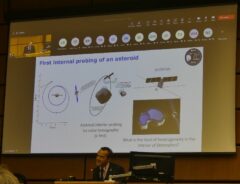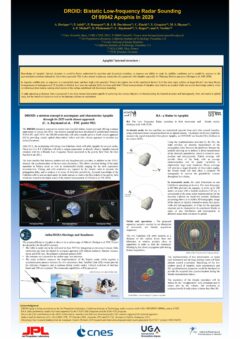The Planetary Defense Conference (PDC) happens every two years and on April, 2023, the 8th edition was this time located in Vienna, the splendid capital city of Austria.
Vienna is home of the United Nations Office for Outer Space Affairs (UNOOSA) and the Committee on the Peaceful Uses of Outer Space (COPUOS), both on the great premises of the United Nations Vienna Office (UNVO) at the Vienna International Centre. A few events were also located at the magnificent Austrian Academy of Sciences (pictured here).
The whole exercise has proved to be a great success for all the NEO-MAPPERS!
Several NEO-MAPP project members presented their results on stage or displayed their posters in the UNVO main hall. In the following paragraphs we do provide an overview of the NEO-MAPPERS scientific contributions.
I – Talking during the first session titled Space Missions, here is Harrison Agrusa, from the Université Côte d’Azur, Observatoire de la Côte d’Azur, CNRS, Lagrange Laboratory in Nice, France, chronologically the first neo-mapper asked to take the floor:
Determination of Dimorphos’s Change in Velocity Resulting from the DART Kinetic Impact
Abstract: On September 26, 2022, NASA’s Double Asteroid Redirection Test (DART) mission successfully impacted the asteroid Dimorphos, the secondary component of the (65803) Didymos binary system [1]. With ground-based radar and photometric observations, it was determined that the kinetic impact reduced the binary orbit period by approximately 33 minutes [2]. From our analysis of the orbit period change and other system parameters, we find that Dimorphos’s along-track orbital velocity component changed by Δ𝑣T = −2.7 ± 0.1 mm/s [3]. This result was achieved using a Monte Carlo technique to sample over a range of plausible pre- and post-impact states of the Didymos system. The Monte Carlo routine was coupled to a Full Two-Body Problem (F2BP) code [4] to account for spin-orbit coupling resulting from the non-spherical shapes and close separation of the two binary components. Each Monte Carlo sample draws a pre-impact semimajor axis, pre-impact orbit period, and post-impact orbit period based on the orbital solution presented in [2]. It also samples over the shapes of Didymos and Dimorphos given in [1]. The F2BP code is used to numerically determine the Δ𝑣T required to connect the pre- and post-impact orbital solution. We verify the numerical Δ𝑣T with analytic models such as a simplified Keplerian approximation with a correction for Didymos’s oblateness. The dominant sources of uncertainty in Δ𝑣 ! are the post-impact orbit period and the pre-impact semimajor axis. The uncertainty in the post-impact orbit period will decrease as ground-based observations continue. We discuss prospects for refining the pre-impact semimajor axis based on a measurement of the post-impact semimajor axis following the arrival of the Hera spacecraft in late 2026 [5].
[1] Daly et al., 2022 submitted; [2] Thomas et al., 2022 submitted; [3] Cheng et al., 2022 submitted; [4] Davis & Scheeres 2022 Icarus 341 113439; [5] Michel et al., 2022 Planet. Sci. J. 3 160.
II – The next NEO-MAPP presentation occurred on the same session and was by Patrick Michel, CNRS Director of research at the Université Côte d’Azur, Observatoire de la Côte d’Azur, Lagrange Laboratory, Nice, France, NEO-MAPP Coordinator and ESA Hera Principal Investigator:
The ESA Hera Mission: Detailed Investigation of the NASA DART Impact Outcome and Characterization of the Binary Asteroid Didymos
Abstract: The Hera mission is in development in the Space Safety Program of the European Space Agency (ESA) in collaboration with JAXA for launch in October 2024 [1]. It will rendezvous with the binary asteroid (65803) Didymos in early 2027 and over the following 6 months will investigate the effects of the successful impact of the NASA DART probe [2] and precisely measure the properties of Didymos and its small moon Dimorphos.
DART was launched on 24 November 2021 at 06:21 UTC and successfully impacted at 6.1 km/s on the 160 meter-size Dimorphos on 26 September 2022 at 23:14 UTC. Two weeks before impact, it deployed the Light Italian Cubesat for Imaging of Asteroids (LICIACube) that provided images during the few minutes following the impact. A campaign of observations from Earth and space provided distant images of the event, which were used to determine a reduction of 33 min in the orbital period of Dimorphos around Didymos.
The Hera mission will investigate the outcome of the DART impact in detail. In particular, it will determine the effects of the impact on Dimorphos’ surface, e.g., whether it produced a crater, and if so its properties, and/or whether it led to global reshaping of Dimorphos. It will accurately measure the mass of Dimorphos, which will allow quantification of the momentum enhancement factor, which is a crucial parameter to evaluate the efficiency of the kinetic impactor technique. Thanks to close proximity operations, Hera will also determine in detail the physical, thermal and compositional properties of the asteroid, including first time measurements of the internal properties, which have a critical influence on the impact outcome. With Hera and DART together, we will have a fully documented deflection test and impact experiment that will allow us to verify our numerical impact models, to be able to extrapolate this deflection test to other asteroids and to improve our understanding of the complex geological properties and response of small asteroids.
Hera consists of a mother spacecraft and two CubeSats. It will perform the first rendezvous with a binary asteroid, arriving at Didymos about 4 years after DART. Hera will not only contribute significantly to the planetary defense effort by documenting entirely the outcome of the DART impact, it will also greatly advance our understanding of processes in the very low gravity regime of a small asteroid (Dimorphos) as well as our knowledge of binary asteroids and asteroid geophysics.
The mission development is progressing nominally, with the Critical Design Review having been passed in November 2022. The primary launch window opens in October 2024 and the mission is on track to meet this date. The various working groups of the Hera Science Team are working intensively to support the mission and be best prepared for the surprises that Hera will offer during its visit to Didymos in 2027.
References: [1] Michel P. et al. 2022. Planetary Science Journal 3: 160; [2] Rivkin A. et al. 2021. Planetary Science Journal 2: 173.
III – Following up, the floor was given to Makoto Yoshikawa from ISAS / JAXA and member of the NEO-MAPP Advisory Board, still on the same session:

Hayabusa2 Extended Mission: Hayabusa2#
Abstract: The asteroid explorer Hayabusa2 successfully returned the samples of asteroid Ryugu to the Earth in December 2020. This is the second asteroid sample return mission in the world following Hayabusa, which brought the samples of asteroid Itokawa back to the Earth in 2010. It has passed more than two years since the capsule of Hayabusa2 was returned to the Earth. Up to now a lot of analyses of the Ryugu samples were carried out, and many interesting materials such as amino acids, liquid water, hydrated minerals, etc. were found.
The spacecraft itself was healthy without any serious problems and there was enough fuel, so we decided to continue the mission, and we call it Hayabusa2 Extended Mission, whose nickname is Hayabusa2#. The character # (SHARP) is the acronym of “Small Hazardous Asteroid Reconnaissance Probe,” which indicates that Hayabusa2# is related to the planetary defense deeply.
The final target of Hayabusa2# is near-Earth asteroid 1998 KY26. This asteroid is very small; the diameter is just about 30m. And it is rotating very fast; the spin period is about 11 min. We have never been to such a tiny asteroid, so scientifically it is very interesting. In addition to this, we must take care of the Earth collision by such small objects, because the probability of collision of this size objects is about once in 100 years. Hayabusa2 spacecraft will arrive at 1998 KY 26 in July 2031. Before arriving at 1998 KY26, Hayabusa2 will flyby near-Earth asteroid 2001 CC21 in July 2026. The flyby velocity is about 5km/s, and we need very precise navigation technique. This is also important for the planetary defense, because if we want to deflect an asteroid which is on a collision orbit to the Earth by impacting spacecraft to it, we need navigation in very high accuracy. Therefore, one of the important purposes of Hayabusa2# is to contribute to the planetary defense activities by getting information of a tiny near-Earth object and by acquiring the technique of the precise navigation.
In Hayabusa2#, the spacecraft will be operated for 11 years or more after the original mission, so the long-term deep space cruising technology is important. To investigate time effects for the hardware of the spacecraft and to get technique of resource-saving operation are also the important purpose. Scientific studies for L-type asteroid 2001 CC21 and very small and fast-rotating asteroid 1998 KY26 are another important purpose of Hauabusa2#.
In this paper, we report the operation status up to now and the future operation plans of Hayabusa2# and summarize the objectives of the mission.
IV – Talking on session “Deflection / Disruption, Testing and Modelling”, let us now introduce Sabina Raducan, from the University of Bern:
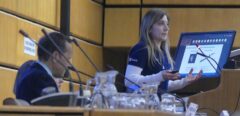
Deflecting rubble pile asteroids: Lessons learned from the DART impact on Dimorphos
Abstract: NASA’s Double Asteroid Redirection Test (DART) impacted asteroid Dimorphos (the smaller component of the 65803 Didymos binary system) on September 26th, 2022 [1]. The impact altered the orbital period of Dimorphos around Didymos by ~33 minutes [2], demonstrating the capabilities of the kinetic impactor as a mitigation strategy for relatively small but therefore more numerous asteroids [3]. The response of an asteroid to a kinetic impact strongly depends on its surface, subsurface and internal properties [e.g., 4-6]. In the case of an incoming hazardous asteroid, a kinetic impactor would have to be designed to maximise the deflection, yet at the same time not disrupt the asteroid.
Using the material properties for Dimorphos that yield the best match to numerical simulations [7] done using Bern SPH [8, 9], numerical simulations of the DART impact outcome with LICIACube [10], and telescopic observations [11], we find that Dimorphos may be a rubble pile (i.e., aggregate held together only by self-gravity and/or small cohesive forces). This prediction will be verified by the ESA Hera mission during its investigation of the binary asteroid, which includes internal probing of Dimorphos with a low-frequency radar [12]. For this rubble pile scenario, we compute the energy required to deform the shape or to catastrophically disrupt Dimorphos.
Our results allow us to determine the minimum asteroid size that can be deflected by a DART-scale kinetic impactor. Besides helping us design future kinetic impactor missions, our results can also be used to constrain the age of Dimorphos and the collisional evolution of such bodies.
References: [1] Daly et al., 2022, Nature; [2] Thomas et al., 2022, Nature; [3] Cheng et al., 2022, Nature; [4] Raducan et al., 2019, Icarus; [5] Raducan et al., 2020, PSS; [6] Stickle et al., 2022, PSJ; [7] Raducan et al., (in prep.); [8] Jutzi et al., 2008, Icarus; [9] Jutzi, 2015, PSS; [10] Dotto et al., 2022 (submitted); [11] Li et al., 2022, Nature; [12] Michel et al., 2022, PSS.
V – Then, let us follow with Robert Luther, photographed standing at the head table, from Berlin’s Museum für NaturKunde, talking on session “Earth Impact Effects and Consequences”:

Predicting the Consequences of NEO Impacts on Earth
Abstract: Small NEO’s can impact Earth with little warning time. Especially smaller NEOs are difficult to be detected and are more numerous than larger ones. In such a scenario, Emergency Agencies require fast and accurate predictions of the impact consequences. However, the time might not be sufficient for running accurate shock physics codes. Here, we present a new approach that allows for fast but still reasonably accurate predictions for a set of input parameters (e.g., speed, size and impact angle of a NEO) defining a giving impact scenario in terms of overpressure, wind speed, thermal radiation on the surface, and the cratering process.
The atmospheric entry of a NEO depends on its physical properties. An iron asteroid is much denser and has a larger strength than a rocky body. Asteroids could be monolithic or a rubble-pile, which also affects their bulk properties. Based on these properties and the asteroid size, we defined the following regimes: 1.) airbursts from relatively small rocky asteroids, 2.) cratering events from larger rocky asteroids, 3.) strewn field formation by relatively small (<30 m) iron asteroids, and 4.) cratering events from larger (>30 m) iron asteroids. Depending on the regime, we use a suite of pre-calculated shock physics models using the SOVA shock physics code [1], the separate fragment approach [2,3,4], or recent interpolation equations [5,6].
Our approach has been tested against available data from observed asteroid falls, and numerical models. A well-studied observed case is the Chelyabinsk event, which occurred on 15.02.2013 [e.g., 7], but we have also used simulation results for a Tunguska-like event, for which data on surface effects was provided [e.g., 8, 9]. Our tool calculates effects in agreement with these literature results.
Our impact effects prediction tool has been developed to allow for fast and accurate predictions of the impact effects for the encounter of small NEOs with Earth. In contrast to previous tools, it is designed to render maps of the predicted effects on a map, which helps emergency agencies for their risk assessment.
References: [1] Shuvalov V.V. (1999) ShockWaves 9, 381-390; [2] Passey Q. and Melosh H.J. (1980) Icarus 42, 211-233; [3] Artemieva N.A. and Shuvalov V.V. (1996) ShockWaves 5, 359-367; [4] Artemieva N.A. and Shuvalov V.V. (2001) JGR 106, 3297-3310; [5] Shuvalov V.V. et al. (2016) SSR 50 (1), 1-12 ; [6] Glazachev D. et al. (2019) Trigger Effects in Geosystems, Springer Proceedings in Earth and Environmental Sciences; [7] Popova O.P. et al. (2013) Science 342, 1069-1073; [8] Shuvalov V.V. et al. (2013) SSR 47 (4), 260-267 ; [9] Artemieva N. et al. (2019) M&PS 54 (3), 592-608.
VI – Then, participating on the Poster session, let us move on to Naomi Murdoch from Toulouse’s ISAE Supaero (at the centre on the below picture, with Stephan Ulamec from DLR on her right and Julie Bellerose from JPL / Caltech on her left), with non the less than two posters. The first poster as first author, the second poster as second author, Colas Robin also from ISAE Supaero being the first:

Compact Geophysical Instrumentation for Asteroid Exploration
Abstract: Understanding the internal structure of asteroids is key for science, planetary defense and future in-situ resource utilisation. In the framework of two European Commission Horizon 2020 projects (PIONEERS and NEO-MAPP), we are developing two complementary in-situ geophysical instruments, designed specifically to fit inside a small asteroid lander and function in the challenging environment of the asteroid surface.
The first of these instruments is a compact, low pass, low power seismometer (Fig. 1a). This seismometer consists of three geophones that will each measure the ground motion along one axis, and dedicated analogue and digital electronics that are developed at ISAE-SUPAERO (Fig 1b). The commercial sensors contain no active electronics and were designed to withstand extreme environments (e.g., terrestrial boreholes). The compact seismometer can image an asteroid’s internal structure by measuring ground motion generated by either natural seismic sources (micro-meteoroid impacts, thermal cracking, tidal quakes, … [1]) or artificial sources (such as the Hayabusa SCI-2 impactor [2]).
The second instrument is a 6 Degrees of Freedom (DoF) instrument that combines MEMS accelerometers and fiber optic gyroscopes. The 6 DoF instrument makes precise measurements of the asteroid’s rotational dynamics. This includes the capability to measure forced librations and the decay of excited rotation states such as the free librations, both of which constrain the internal structure [3]. The 6 DoF instrument can precisely measure the landing dynamics in order to probe the mechanical surface properties [4], and could also be used to study the internal structure during active seismic experiments.
This presentation will discuss the design, status and complementary nature of these two compact instruments. These geophysical instruments, capable of precisely monitoring dynamical changes during the close encounter with the Earth in addition to measuring tidal force-induced seismicity, would be ideal for inclusion in a small lander to a target like asteroid Apophis.
Acknowledgments: The authors acknowledge funding support from the European Commission’s Horizon 2020 research and innovation programme under grant agreement No 870377 (NEO- MAPP project) and No 821881 (PIONEERS project).
References: [1] Murdoch, N. et al., (2017) Planetary and Space Science, 144, 89-105; [2] Arakawa, M., et al. (2020). Science, 368(6486), 67-71 ; [3] Bernauer, F. et al. (2020) Earth, Planets and Space 72:191; [4] Murdoch, N. et al., (2022), Europlanet Science Congress 2022, Vol. 16, EPSC2022-910.
Boulder morphology at the DART impact site
Abstract: On 26 September 2022, the DART spacecraft intentionally impacted the surface of Dimorphos with the aim of changing the asteroid’s trajectory. Fewer thantwo seconds before the impact, the DRACO instrument was able to capture a high-resolution image of the impact site with a pixel scale of 5.5 cm. (Fig. 1a).
This image presents a blocky terrain covered with large rather elongated boulders up to 6.5 m in length, and a lack of finer material. The shapes of the boulders in the impact area, and their sizes with respect to the DART spacecraft, influence the ejecta properties and as such the efficiency of the deflection of Dimorphos. Boulder morphology is, therefore, important to fully understand the DART impact but can also provide information about the evolution and mechanical properties of Dimorphos’ surface itself.
(a) (b)
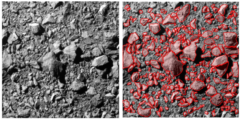
Figure 1: Penultimate image of Dimorphos’ surface taken by the DRACO instrument aboard the DART probe (a) and the same image with the boundaries of the selected boulders (b). Dimorphos north is toward the upper right. The pixel scale is 5.5 cm.
Here, we will present an analysis of several key morphological characteristics of the boulders at the DART impact site. These parameters include the boulders’ eccentricity, sphericity, compactness (a measure of large-scale roundness) and solidity (a measure of small-scale roughness). The presentation will include details of the image processing pipeline, and an interpretation of the morphological descriptors.
This processing and interpretation also help to be best prepared for the rendezvous of the ESA Hera mission with Didymos in 2027. The Hera which will offer detailed imaging of boulders on the whole surface of both of the bodies, allowing us to check our predictions based on DART images.
Acknowledgements: This project has received funding from the European Union’s Horizon 2020 research and innovation programme under grant agreement N°870377 (project NEO-MAPP) and CNES.
VII – Also participating on the Poster session, let us now continue with Alain Herique, from Université Grenoble-Alpes and IPAG, also with two posters:
DROID: Bistatic Low-Frequency Radar Sounding of 99942 Apophis in 2029
Abstract: Our knowledge of the internal structure of asteroids entirely relies on inferences from remote sensing observations of the surface combined with theoretical modelling (Herique et al. 2018). Is Apophis a rubble-pile, as expected, or a monolithic rock, and how high is the porosity? What is the typical size of the constituent blocks? Are these blocks homogeneous or heterogeneous? If Apophis is bilobed, how does the material differ between each lobe? Direct measurements of Apophis deep interior are needed to better understand its accretion and dynamical evolution, to improve our ability to study its stability conditions and to model its response to the gravitational constraints induced by Earth close approach. This is also crucial to plan any interaction of a spacecraft with Apophis especially for Planetary Defense purposes.
Radar observation of Apophis from a spacecraft is the most mature technique capable of achieving these objectives, by providing a direct measurement of its interior. This is the goal of the DROID, Distributed Radar Observations of Interior Distributions, a mission concept developed in collaboration between NASA JPL and CNES (Raymond et al, this meeting). The DROID mothership will release two CubeSats each with a low-frequency radar. The radar will be a version of JuRa (60 MHz) (Herique et al, this meeting), modified to operate in a bistatic mode. The mothercraft and daughtercraft will also have cameras for both science and navigation.
Each daughtercraft radar can operate in a monostatic mode, or in a bistatic mode using the two platforms to measure the signal transmitted throughout Apophis, as CONSERT on Rosetta/ESA. Then, the inter satellite link between mothercraft and daughtercrafts provides the synchronization of the two electronics allowing absolute measurement of the propagation delay in bistatic mode. The monostatic radar mode offers a larger penetration (up to 100 meters or more) with a limited resolution (≈20 m). It corresponds to the radar under implementation for the Juventas Cubesat on Hera/ESA mission (Herique et al, this meeting). Multipass processing allows us to build a 3D tomographic image of the interior to identify internal structure like layers, voids and sub-aggregates, to bring out the aggregate structure and to characterize its constituent blocks in terms of size distribution and heterogeneity at different scales from submetric to global. Shallow subsurface characterization and radar images to support to shape modelling are also possible in this configuration, but with degraded performance due to a limited resolution.
The bistatic radar mode will firstly measure the signal in transmission, allowing us to achieve a direct measurement of the dielectric permittivity, which is related to composition and microporosity. This mode is less demanding in terms of data volume and operation compared to full bistatic coverage. Partial coverage will provide slices of the body with average characterization and its spatial variability to characterize large scale structures. Dense coverage will provide a larger diversity of observation angles, the bistatic mode will then allow a complete 3D tomography benefiting from angular decorrelation of the size effect and permittivity contrast in the return power.
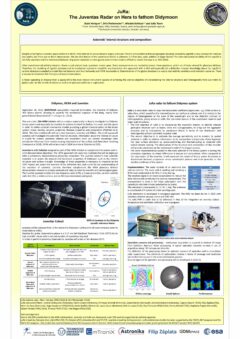
Click on the picture to enlarge.
JuRA: The JUVENTAS Radar on Hera to Fathom Dimorphos
Abstract: Five years after the impact of DART/NASA on Dimorphos, ESA HERA mission will be a unique opportunity to observe in detail this bodies, the crater and the ejecta in order to better constrain mechanical models providing a global characterization of the binary system: shape, density, dynamic properties, thermal properties and composition. The Hera mothercraft will carry two CubeSat’s, Juventas and Milani. The small spacecraft Juventas will investigate the asteroids’ internal structure. Information about the internal structure is crucial for science, planetary defense and exploration since our current knowledge relies entirely on inferences from remote sensing observations of the surface and theoretical modelling.
JuRa is a monostatic radar, BPSK coded at 60MHz carrier frequency and 20MHz bandwidth, inherited from CONSERT/Rosetta and redesigned in the frame of the AIDA/AIM phase A/B. The instrument design is under validation for a flight model delivery end of 2022. JuRa maps the backscatter coefficient (sigma zero – σ0) of the surface and of the subsurface, which quantifies the returned power per surface or volume unit. It is related to the degree of heterogeneity at the scale of the wavelength and to the dielectric contrast of heterogeneities, giving access to both, the sub-meter texture of the constituent material and larger scale structures.
– The first goal of JuRA is to characterize the moonlet’s interior, to identify internal geological structure such as layers, voids and sub-aggregates, to bring out the aggregate structure and to characterize its constituent blocks in terms of size distribution and heterogeneity at from submetric to global scale.
– The second goal is to estimate the average permittivity of the moonlet and its spatial variation in order to retrieve information on the composition and porosity. Radar signals bypasses the near surface alteration due to the space-weathering and thermal- cycling as which is observed with the optical remote sensing. The observation of the structure and composition of the moonlet will provide constraints on the mechanical model of the impact process.
– The secondary objective is to characterize the main asteroid of the binary system to detect differences in the texture and in the composition when compared to the observation of the moonlet. This will permit to constrain the model of binary system formation, to discriminate between progressive versus catastrophic process and more generally to constraint the stability conditions of the system.
In this talk, we will review the JuRa science objectives and the instrument development status. We will show the results of the model end-to-end tests and the corresponding instrument performances. Then we will present the proposed radar operation strategy and the developed approaches for data processing.
VIII – Then let us move on to University of Alicante, also displaying two posters. The first poster with Adriano Campo Bagatin (seen here on the left) as the third author and the second poster with Po-Yen Liu (seen here on the right) as first author and Adriano as the second:
Monte Carlo modelling of the dust ejecta generated by the DART impact on dimorphos surface
Abstract: On September 26th 2022, the NASA/DART spacecraft impacted on Dimorphos, the secondary component of the (65038) Didymos system. The impact generated an extensive cloud of dust debris that evolved into a comet-like dust coma and tail, in a way similar to some active asteroids, as we had predicted in advance[1]. The tail is still detectable after two months since the impact event. In order to assess the physical properties and mass of the ejecta, we have developed a Monte Carlo model for the dynamics of the dust particles, including the computation of the dust coma and tail brightness images as a function of time. The resulting synthetic images are then compared to the high spatial resolution Hubble Space Telescope images acquired since impact time till October 15th, 2022 [2]. A trial-and-error procedure is devised in order to find the physical parameters that best fit the observations.
The dynamical model takes into account the combined effect of the gravity of Dimorphos, Didymos, and the Sun, as well as the solar radiation pressure, on the ejected particles. To fit the HST images, we found that two ejecta components have probably been generated after the impact. On one hand, most of the dust particles are ejected at relatively high speeds on the surface of a cone with a thickness of about 10-degree, cone opening angle of some 120-degree, and having the cone axis oriented nearly opposite to the calculated impact velocity vector. In addition, a low-velocity ejecta component, with isotropic distribution, and with velocities comparable to Dimorphos escape velocity (0.09 m/s) would have also been generated. The first ejecta component led to the northern and south-eastern arms seen in the HST and ground-based images (Fig.1a and Fig.1b). The largest particle population of the two ejecta components escape from the Hill sphere of the binary system at different timeframes, leading to the double tail structure seen in the HST images since early October (Fig.1c and Fig.1d). In the simulations shown, a differential power-law size distribution function of index -2.5 has been used, with minimum and maximum particle sizes at 1 μm and 1 cm.
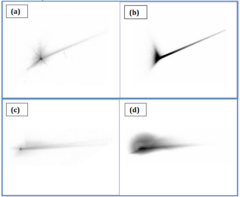
Figure 1. Ejecta patterns on 28.1 September (panels (a) and (b)) and 11.87 October 2022 (panels (c) and (d)). Panels (a) and (c) show the HST images, and (b) and (d) the corresponding Monte Carlo simulations. All images are displayed in the same logarithmic brightness stretch.
Although many of the features are already reproduced in the simulations, there are still some patterns that are not. Examples are the brightness excess near the optocenter, and the corrections needed to fit more closely the orientation of the emitting cone (see Fig.1b and Fig.1d). An in-depth study of the sensitivity of the input parameters to the output images is under way.
References: [1] Moreno, F. et al. 2022. Ground-based observability of Dimorphos DART impact ejecta: photometric predictions. MNRAS, 515, 2178. [2] Li et al. 2023 Ejecta from the DART-produced active asteroid Dimorphos, submitted.
Tidal effects on the shape and structure of Apophis during the Earth flyby in 2029
Abstract: 99942 Apophis (2004 MN4) was well known over the last two decades because it set the record for the highest rating on the Torino impact hazard scale with level 4 on December 27, 2004. With subsequent improved observations, the possibility of an impact on Earth was ruled out. As calculated by the JPL Center for NEO Studies (CNEOS) and by the ESA NEODyS-2, Apophis will have a non-threatening close encounter with the Earth at 39000 km from its centre on April 13, 2029. The tidal effect on Apophis induced by such an extraordinarily close approach with the Earth is not yet determined since the internal structure of the asteroid is unknown. Asteroids larger than 100-200 m and smaller than some 100 km in diameter are most likely gravitational aggregates (GAs) [1][2], gravitationally reaccumulated leftovers of catastrophic collisions to their parent asteroids. Therefore, their components are held together mainly by self-gravity, with contribution from other forces (cohesion, friction, interlocking, etc.). In this work, we assume a GA internal structure for Apophis and we apply our internal structure model to the currently available shape model. We model internal structure by means of irregular shape components of different sizes using a SSDEM high-performance parallel gravitational N-body code, PKDGRAV [3][4][5]. Irregular components are obtained by grouping together particles forming irregular overall shapes, in which relative particle motion is inhibited (rigid-aggregates). Such components may be produced according to arbitrary mass distributions. We perform simulations of the 2029 close encounter with the Earth and follow the evolution of the object. We present the model outcome of possible changes in the shape and structure of Apophis as well as changes to its spin state. DeMartini et al. (2019) [6] tackled this problem with PKDGRAV, using mono-disperse hexagonal-close-packing configuration of spherical particles for the internal structure of Apophis. Further refinement included poly-disperse distributions of spherical particles mixed with some larger rigid-aggregate components (PDC 2021). They also suggested future work to model Apophis as two large rigid-aggregate cores covered by layers of regolith that resembles a contact binary, since the most recent best-fit shape model of Apophis suggest such structure [7]. The outcome of the present model will be compared with DeMartini’s outcome. Furthermore, we compute the gravity field of the body before and after the encounter with the aim to set requirements to the needed sensitivity of a gravimeter on board a rendezvous space mission. Such measurements may potentially reveal Apophis structural changes during the Earth encounter.
References:[1] Campo Bagatin, A., Petit, J.-M., Farinella, P. 2001. Icarus, 149, 198-209 ; [2] Richardson, D.C., Leinhardt, Z.M., Bottke, J.W.F., Melosh, H.J., Asphaug, E. ; 2002. In: Bottke Jr., W.F., Cellino, A., Paolicchi, P., Binzel, R.P. (Eds.), Asteroids III; University of Arizona Press, Tucson; [3] Richardson, D.C., Quinn, T., Stadel, J., Lake, G. 2000. Icarus 143, 45–59; [4] Stadel, J.G. 2001. Ph.D. Thesis, 3657; [5] Schwartz, S.R., Richardson, D.C., Michel, P. 2012. Granular Matter 14, 363–380; [6] DeMartini, J.V., Richardson, D.C., Barnouin, O.S., Schmerr, N.C., Plescia, J.B., Scheirich, P., Pravec, P. 2019. Icarus, 328, 93-103; [7] Brozović, M., Benner, L.A.M., McMichael, J.G., Giorgini, J.D., Pravec, P., Scheirich, P., Magri, C., Busch, M.W., Jao, J.S., Lee, C.G., Snedeker, L.G., Silva,M.A., Slade, M.A., Semenov, B., Nolan, M.C., Taylor, P.A., Howell, E.S., Lawrence, K.J., 2018. Goldstone and Arecibo radar observations of (99942) Apophis in 2012–2013. Icarus 300, 115–128.
IX – Following that, let us move on to the local, i.e. Austrian, member of NEO-MAPP, Stephan Ulamec, from DLR, the German Aerospace Center, seen on the left side and Patrick Michel, NEO-MAPP Coordinator, seen on the right:
The NEO-MAPP project, funded by the European Commission in support of the ESA Hera mission
Abstract: NEO-MAPP, a project funded by the H2020 program of the European Commission, stands for Near Earth Object Modelling And Payload for Protection and addresses the topic “Advanced research in Near Earth Objects (NEOs) and new payload technologies for planetary defence” (SU-SPACE-23-SEC-2019).
In the frame of the NEO-MAPP project, the ESA Hera mission has been selected as prime reference scenario. Hera has been approved by the ESA Council at Ministerial Level, Space19+, in November 2019 for launch in 2024. The main goal of NEO-MAPP is to support the development and data analysis of NEO missions, as Hera. It will provide significant advances in our understanding of the response of NEOs to external forces (in particular a kinetic impact like the one demonstrated with the NASA DART mission in September 2022, or a close planetary approach), as well as in interpreting the associated measurements by a spacecraft (e.g. those necessary for characterizing the physical and dynamical properties).
The NEO-MAPP objectives, include:
- Pushing the limits of numerical modelling of the response of NEOs to a kinetic impact, as well as of their physical and dynamical properties while maturing European modelling capabilities linked to planetary defence and NEO exploration.
- Increasing the maturity of multiple spaceborne and landed European instruments directly related to planetary defence, while focusing on measurements of surface, shallow sub-surface and interior properties of NEOs.
- Developing algorithms and simulators to prepare for close-proximity operations and payload data analyses and exploitation.
- Developing innovative and synergetic measurement and data-analysis strategies that combine multiple payloads, to ensure optimal data exploitation for NEO missions.
- Developing and validating robust GNC strategies and technologies enabling surface interaction and direct response measurements performed by CubeSat or small/micro-lander (μLander) architectures.
Building on the expertise of NEO-MAPP consortium partners, who are directly involved in the Hera mission and, in some cases, also in other relevant missions (e.g., NASA OSIRIS-REx, JAXA Hayabusa2 or MMX), the NEO-MAPP consortium is in a perfect situation to further advance NEO scientific research and payload technologies. NEO-MAPP is also dedicating considerable resources to developing important and innovative synergies between the sub-topics (modelling, instrument development and data analysis). Consequently, NEO-MAPP will provide significant advances in our understanding of NEOs while at the same time build upon and sustainably increase the expertise of European scientists and engineers in both planetary defence efforts and small-body exploration.
Acknowledgement: This project has received funding from the European Union’s Horizon 2020 research and innovation programme under grant agreement No 870377 (project NEO-MAPP).
X – Last but not least, our Communication & Outreach work package of the Project, including Anna Bordus, Rhea Abdo (both part of the Asteroid Foundation, AF) and Julien Serrecourt (Université Côte d’Azur, Observatoire Côte d’Azur, CNRS, Lagrange lab.), also with previous support from Colleen Fiaschetti (B612 Foundation and former AF director); the last two seen here standing aside the outreach activities poster:
Planetary defense outreach activities in the framework of the NEO-MAPP project funded by the European Commission
Abstract: NEO-MAPP stands for Near Earth Object Modelling And Payload for Protection. This project is funded by the Horizon 2020 program of the European Commission and addresses the topic “Advanced research in Near Earth Objects (NEOs) and new payload technologies for planetary defence” (SU-SPACE-23-SEC-2019).
As part of the project, a work package is dedicated to the dissemination of results and public outreach. This includes the promotion of project results among professional and scientific community peers as well as general Public Relations (PR) activities involving a website presence and outreach on social media platforms to promote the project and to increase the level of awareness of the importance of planetary defense.
The project adopted the Hera mission under development at the European Space Agency (ESA) as the reference mission. A major part of the NEO-MAPP activities, including the outreach, support the mission preparation and future data interpretation.
A – General considerations
Planetary defense is an important and fascinating topic for the public. As astrophysicists and science communication officers, we are keenly noticing that the study of ways to protect the Earth from potential threats from space, such as asteroids or comets that could collide with our planet is a topic amazing the audience.
Here are some key points we thought to consider when building a communication plan around our topic:
- To emphasize the importance of planetary defense: to start by explaining why planetary defense is important. To talk about the potential risks posed by space debris and how they could affect life on Earth. Finally, to discuss
the history of major impacts in the Earth past, and how they have shaped our planet, all of that without generating unnecessary fears.
- To explain the scientific research behind planetary defense: to dive into the scientific research that goes into studying these threats. Talk about how astronomers and astrophysicists search for and track Near-Earth Objects (NEOs), and how they calculate their orbits to determine whether they pose a threat to Earth. Discuss the tools and techniques used to monitor the skies, such as ground-based telescopes and space-based observatories.
- To outline the different approaches to planetary defense: There are various approaches to planetary defense, including deflection, a method that proved to be functional, with the NASA’s DART mission, and other techniques not yet implemented or, even, not authorized to be tried. To discuss these methods and to explain how they work. For example, deflection techniques involve changing the trajectory of an object so that it misses Earth, while disruption techniques involve breaking up the object. The aim is to talk about the advantages and disadvantages of each approach, and the challenges associated with implementing them.
- To highlight the global effort to protect our planet: to emphasize the fact that planetary defense is a global effort. To Talk about international collaborations, such as the United Nations Office for Outer Space Affairs (UNOOSA), the International Asteroid Warning Network (IWAN) and the Space Mission Planning Advisory Group (SMPAG) that are working to develop strategies for dealing with potential threats from space, to evaluate and to warn about a potential threat and to plan an appropriated and coordinated response. It is also primordial to discuss how different space agencies are contributing to this effort, notably the Planetary Defense Coordination Office (PDCO) at NASA and the Planetary Defence Office (PDO) at ESA, and how individuals can get involved, especially amateur astronomers monitoring the sky for NEOs.
Overall, a communication plan around planetary defense should focus on educating the public about the potential risks of NEOs and space debris on one hand and the scientific research and methods used to mitigate these risks on the other hand. By emphasizing the importance of planetary defense and highlighting the global effort to protect our planet, we help raising awareness about this important topic, without causing undue alarm.
B – Involvement of the European Union in planetary defense
The European Union (EU) has taken an active role in the field of planetary defense, working to develop strategies and technologies to mitigate potential threats from asteroids and other NEOs.
In 2016, the EU established the Space Surveillance and Tracking (SST) program, which aims to develop a comprehensive system for monitoring space debris and tracking potentially hazardous objects. The SST program involves a network of ground-based telescopes and radar systems, as well as space-based sensors, that work together to detect and track objects in space.
In addition to the SST program, the EU has also invested in research and development of deflection and disruption technologies. In 2012, it funded for 3 years the NEOShield consortium in its FP7 program, followed in 2015 by the NEOShield2 Consortium funded for 2.5 years in its Horizon 2020 framework, aimed at studying the kinetic impactor technology and modelling, as well as characterizing NEOs with ground-based telescopes. In 2020, NEO-MAPP and NEOROCKS were then funded by the Horizon 2020 framework for 3 years to support different NEOs related activities.
Overall, the EU has demonstrated a strong commitment to planetary defense and is actively working to support the development of technologies that can help protect the Earth from potential asteroid impacts.
C – Communication activities in NEO-MAPP
NEO-MAPP started in February 2020. Within its framework various events (e.g., public lectures, space cafes) have been organized. Regular contributions to the public website help to raise public awareness of the hazard posed by small celestial bodies and the efforts made to mitigate it. Effective public outreach activities are also performed to inform the public and interested parties of the advances of the various tasks of the project and the Hera mission development, which include press releases of publications in major international peer-reviewed journals by the team, dissemination of information for the public via both the project and the Hera community websites, collaboration with journalists, coordination of articles for the popular literature, public lectures, interviews for social networks, televisions, radios and other on-line medias.

figure 1: Public conference of Dr. Patrick Michel

figure 2: TV documentary with Dr. Naomi Murdoch

figure 3: NEO-MAPP media exposure
 figure 4: NEO-MAPP potential reach
figure 4: NEO-MAPP potential reach
Figures 1 and 2 show examples of our efforts to promote the topic of planetary defense and its various areas of study, such as those performed within our project and the Hera mission preparation. In addition, figures 3 and 4 show the metrics (made with Meltwater) we use to measure the impact of our planetary defense outreach activities on the public and medias.
Acknowledgments: We acknowledge funding support from the European Union’s Horizon 2020 research and innovation framework program under grant agreement N° 870377 (project NEO-MAPP) and ESA.
Julien Serrecourt, Communication & public relationship officer
Dr Patrick Michel, Coordinator



